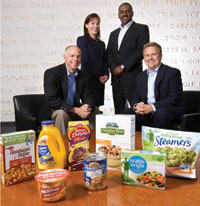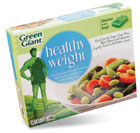
General Mills has emerged as one of the best-performing big food companies in a tight economy. Here's how packaging helps.
This is one of three articles about our food packager of the year, General Mills. To read the other stories, click on the headlines below.
Portion packs cater to on-the-go consumers
Raising the bar on granola--and elsewhere
General Mills has emerged as one of the best-performing big food companies in a tight economy. Here's how packaging helps.
General Mills is general, all right.
The $13.7 billion company has a product portfolio so diverse that an entire big wall in the visitors’ center in its Minneapolis headquarters is covered with the names of its products. The “Mills” part, of course, reflects the Big G cereals, like Cheerios and Wheaties, that represent 22% of its sales.
But General Mills products also include Yoplait yogurt; Pillsbury frozen and refrigerated dough, and other baked and grain-based products; Häagen-Dazs ice cream; Progresso canned soup; Old El Paso Mexican foods and meal kits; Green Giant canned and frozen vegetables, and much more. (Editor's Note: Pillsbury branded dry baking mixes are owned by the J.M. Smucker Co. and not General Mills.)
Its packaging is as diverse as its products. General Mills uses just about every conceivable kind of packaging material, and it regularly rolls out innovative packages of all kinds (see “Portion packs cater to on-the-go consumers” on p.32). Packaging is an integral part of the company’s impressive recent performance. Sales for the 2008 fiscal year (ending May 28) were up 10% and earnings up 13%, the first double-digit rise in sales since the company bought Pillsbury in 2001.
This success, with packaging and in overall performance, is why General Mills isFood & Beverage Packaging’s2008 Food Packager of the Year, a repeat performance from 2003.
Packaging improvements at General Mills comprise everything from high-profile new products to money-saving refinements that few consumers will notice. Nurturing these ideas, and coordinating them across the vast organization, is a major part of General Mills’ packaging initiative.

The Health Blends line extension of Green Giant consists of combinations of frozen vegetables chosen for their specific health benefits. The cartons feature these benefits, like "immunity boost" or "healthy weight," in large type inside a big circle.
Coordinated effort
The company’s approach to packaging strategy is a mix of autonomy and companywide coordination. Packaging is aligned by business unit, meaning that each of the company’s major divisions, such as Big G cereals and Yoplait, uses its own resources for developing and executing the packaging for its products. But packaging still is centralized in Minneapolis, says Carol Cady, director of packaging research and development.“The way our packaging group is, we’re aligned by division, but we’re located centrally as the packaging organization,” Cady says. “And that way, we’re really able to share stories and insights and ideas across the packaging development community. And we’re able to coach and mentor each other. So it’s kind of a matrix organization.”
This matrix has several aspects. Packaging Partners is what Cady calls a “virtual team” that includes all the functions focused on packaging, including R&D, sourcing, brand design, engineering and operations. “That way, we’re able to take in all the different perspectives and experience from each of those different functions that contribute to packaging and really get alignment,” she says.
This year, General Mills set up “Strategy Map Teams,” cross-functional and cross-divisional, that are organized by packaging material, like metal, paperboard, rigid plastic or flexible film. These teams lay out a five-year strategy for the company’s potential use of each material, looking at aspects like innovation, sustainability and supplier partnerships.
“We’re able to get to bigger ideas or opportunities that cut across multiple divisions that are tied to a common platform,” Cady says.
John Allgaier, director of packaging sourcing, says that the Strategy Map Teams are also a good way to get packaging suppliers on board with what General Mills will need in the immediate future.
“It’s all about focus, for suppliers as well as General Mills,” Allgaier says. “When our suppliers talk to us, they aren’t going after the latest need of an individual R&D scientist or the latest need of operations. They’re going at it more strategically, saying, ‘I understand General Mills from a leadership standpoint. These are the places you want me to place my bets.’”
Cady also leads the “G-Tech Packaging Team,” a group that looks at emerging packaging technologies. This is another across-the-board approach.
“The G-Tech team that I lead interacts with all of the divisions,” Cady says. “So we can find an enabling technology that might have applicability in three or four of those divisions.
Holistic approach
Perhaps the most prominent companywide effort at General Mills is Holistic Margin Management (HMM). It’s a method of systematically driving out costs from all aspects of the business, by eliciting feedback from plant employees, product development, marketing, finance and consumer insights.Cady describes HMM as a process of continuous improvement, done at the plant level. A line operation is examined from start to finish for unit operations that may be wasteful, have unnecessary steps or use excessive materials.
“We’re looking for all of those areas that are not value-added, that we can eliminate,” Cady says.
An example of packaging economy that was made through HMM had to do with the foil lids for single-serve Yoplait yogurt. The lids had come in three colors for different flavors, with the attendant difficulties in ordering and maintaining stocks. During an HMM review, the suggestion came to go to single-color lids. Consumer research showed that the monocolor lids didn’t detract from the product’s shelf recognition, or “shoppability.” Single-color lids were instituted last year, for an annual savings of $2 million.
A more comprehensive savings project through the HMM process came with Hamburger Helper, General Mills’ iconic line of hamburger casserole mixes.
The HMM review determined that two big contributing factors to the bulk of a Hamburger Helper carton were the bent shape of the pasta noodles and the presence, in some varieties, of multiple pouches of toppings. The suggestion emerged to flatten out the noodles and pare the topping pouches down to one. Consumer research revealed that the flatter noodles were fine with consumers, and that they didn’t value the extra toppings-in fact, they preferred one pouch, because it made preparation more convenient. The result was a carton that, while keeping the same width and height for a consistent billboard, cut the depth for a 20% reduction in overall fiber use (estimated savings: almost 900,000 pounds of paper annually) that allows significantly more cartons to be loaded onto a truck.
The asset of equity
Brand equity is one of General Mills’ most important assets. It’s more valuable now than ever, according to food industry analysts like Tim Kenyon of GfK Custom Research. Strong brand equity can help companies like General Mills pass along increased costs. In fact, strong brands have extra appeal when consumers cut back on eating out, Kenyon told the Minneapolis Star-Tribune: “They may actually be willing to spend a little more on the nicer products because they know they’re not going out as much.”Maintaining brand equity has been the focus of ongoing redesign efforts, says Mark Sullivan, General Mills’ brand design director. One of the company’s overall imperatives has been to strengthen the impact of packaging graphics through simplification and focus.
“One of the areas that we’re trying to be more diligent around are some pretty basic design principles,” Sullivan says. “What has happened over the course of I don’t know how many years, and it’s not just General Mills but a little bit of a packaged goods phenomenon, is that people have just been throwing more and more junk onto the package…. And so one of our missions is to really clean up the package, so that the product itself can stand out and also help reduce the noise that’s happening in these categories.”
Green Giant makeover
Sullivan cites Green Giant vegetables as an example of this principle in action. One goal of a recent redesign was to back up the company’s message that frozen veggies have as many, and in some cases more, nutritional benefits than fresh. Reducing the number of graphic elements on the package was a way to focus on these benefits.“A lot of that was driven by keeping the package very clean, to really highlight the food,” Sullivan says. “Because we’re a food company, and consumers really shop and eat with their eyes, [we asked ourselves] how do we make the product look as appetizing as possible? Ensure there’s room to breathe on the package, and there isn’t too much clutter surrounding the key things we want the consumer to take away.”
For its packaging graphics, General Mills conceives strategy in-house, but counts on third-party firms for the actual graphics design. This approach helps keep the company’s graphics from getting stale, Sullivan says. Even though, in practice, General Mills mostly uses the same half-dozen or so design firms, the use of outside firms means it can always go to a completely new source.
“You continue to stay fresh,” Sullivan says. “You get a lot more external perspective. The popular school of thought is that the more it stays internal, the more you’re not bringing in a lot of innovation, because people are so used to working on the same thing over and over again.”
Packaging, in just about every form conceivable for food, will continue to be a way for General Mills to leverage the advantages of its vast operations and product portfolio.
“We’re really all about driving our new brands and re-energizing existing products,” Cady says. “Convenience is one of the key levers that we’re always going after with packaging, but we’re also very interested in winning at the shelf, so packaging that will increase our shelf presence or merchandising power is important to us. We’re also looking for breakthrough productivity.” F&BP
